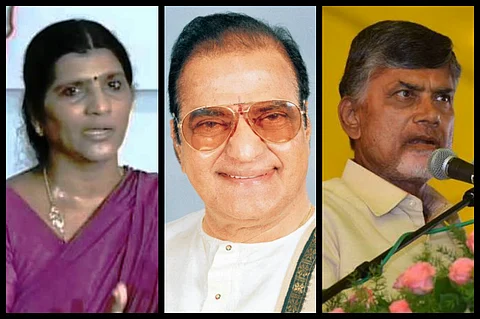

Telugu actor and TDP legislator from Hindupur Nandamuri Balakrishna recently announced that he would act in, and produce a biopic of his late father and founder of the TDP Nandamuri Taraka Ramarao (NTR).
After the announcement, Balakrishna’s stepmother and second wife of NTR, Lakshmi Parvathy has threatened to take him to court if the biopic portrayed the present Chief Minister Chandrababu Naidu as a hero.
She believed and continues to believe that Naidu, along with his coterie comprising NTR’s other son-in-law Daggubati Venkateswara Rao and NTR’s two sons, Nandamuri Harikrishna and Balakrishna, backstabbed NTR and usurped the party and the government.
She is being called a ‘vamp’, just as she was labelled a vamp back in 1994-95; vamp because, apparently, she tricked the rich old senile patriarch with her ‘wifeliness’. Now such tropes are not uncommon in a deeply patriarchal country like India, and especially in a society like Andhra Pradesh which still continues to live culturally, at least, in the 15th or 16th century.
For what else would one call a woman as greedy and as ambitious and as intelligent as any other man in such a society?
Often political struggles seem to be filled with so much drama and contingency that understanding them, in the sense of locating them in the grand continuity of history, becomes extremely confusing. Lenin is said to have once remarked that politics is nothing but concentrated economics. To be sure, this does not mean vulgar economic determinism, but only an acknowledgement that more often than not, economic contradictions play out in cultural forms.
In this sense, the rise of the TDP or any regional movement for that matter is characterised as the rise of the regional bourgeoisie to control their own affairs. But this is couched usually in the language of sub-nationalism or regionalism or federalism. This regional bourgeoisie in Andhra Pradesh comprised of the Kammas, although not restricted to them alone, whose vanguard was the TDP.
Their social consciousness was formed as part of various movements including the freedom movement, the communist, rationalist and atheist movements. With the Green Revolution they evolved as a fully dominant regional economically powerful community. They needed political power to consolidate and evolve further. And NTR with his ‘self-respect’ trope was the man of those times.
His TDP party replaced the Congress, which as part of its strategy of ‘unitary’ India never allowed for regional bourgeoisie to occupy positions of power in state assemblies. But since the Congress was still in power at the centre, this regional bourgeoisie did not want to pick unnecessary fights with the centre, which was back then, the sole distributor of the spoils of international financial capital in the throes of giving birth to the New World Order (NWO).
But NTR, who fooled himself into believing that he was indeed Kalki, did not pay heed to this class and picked constant fights with the Congress at the Centre. Moreover, thanks to his populist policies like cracking down on arrack and Rs 2/kg rice, he had to face a backlash. This came in the spring of 1984, when he was away in America to get a heart surgery done, in the form of Nadendla Bhaskar. It was averted by the popular support of the common people.
By then, Naidu, who was also NTR’s son-in-law, had already moved from the Congress to the TDP. The maverick nature of NTR as the CM, was balanced by the organisational grip that Naidu maintained within the TDP. This ensured that the party did not split.
Later, NTR married his biographer Lakshmi Parvathy, who in her own right, was as shrewd and ambitious as Naidu or any other politician at that time. As an alternate power centre was created in the ‘kitchen’ (common phrase used in the press back then) by Parvathy, TDP leaders started picking sides.
By then, the NWO had been ushered in by PV Narasimha Rao and Manmohan Singh. And since the NWO stressed efficiency over equity, what it needed was managers and not politicians; in other words, CEOs and not CMs.
Interestingly, Naidu prides on calling himself the CEO of Andhra Pradesh. And ‘Eenadu’ which took pride in being the tool of propaganda for NTR during his campaign, now clearly wanted to expand into other areas. So they picked a side, that of Naidu, and unleashed a wave of patriarchal propaganda against Parvathy, lampooning her as the cook, cleaner, maid and ‘keep’; which wasn't very difficult to digest for the readers for they were hardwired in the same regressive culture.
Thus, all Naidu needed was the support of NTR’s family because he anyway had the party in his hand for a very long time. This support came in the form of NTR’s sons, one of whom was made the transport minister in Naidu’s cabinet. He also understood very well that he had the best assembly that money can buy.
The internal party coup played out in August 1995 and an indignant NTR, who was desperate to explain to anybody who cared to listen about this ‘treachery’ (he used the exact same word in a press meet) finally died in January 1996.
Parvathy was discredited and reduced to a vamp. Naidu went on to become the 'World Bank' man, evident from those 12 white papers he released soon after he became the CM. And the high rise towers of Cyberabad and Hi-tech city, erased from memory the question of ethics and events of 1995.
Note: Views expressed are personal opinions of the author.